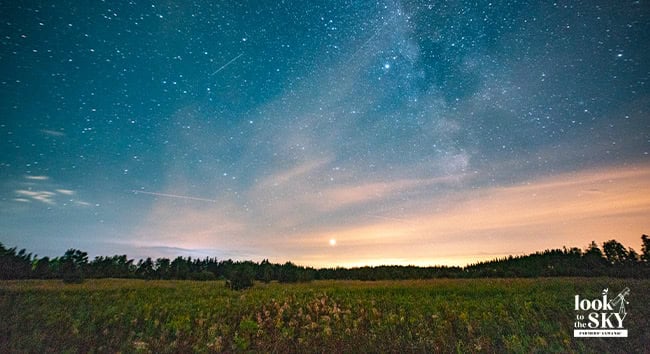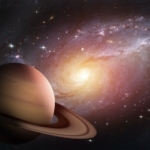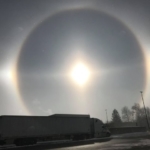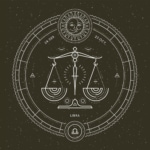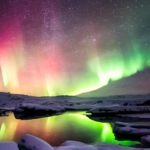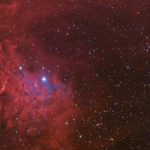The March night sky has many highlights, including many bright planet pairings with Moon, iconic stars, and the Full Worm Moon reaching peak illumination during the first few days of spring! A couple of sky events worth noting: Jupiter and the Moon meet again in the March sky nearly a month after their celestial “kiss” on Valentine’s Day. Also, catch a rare eclipse of Antares, a bright red star that symbolizes the heart of Scorpius (Scorpio). Plan your stargazing adventure with Farmers’ Almanac Monthly Night Sky Guide!
Watch out for the telescope emoji – 🔭 – which means we recommend binoculars or telescopes. Looking for a great starter telescope? Check out our Starry Nights Gift Guide, filled with gifts for sky enthusiasts of all ages and levels of experience.
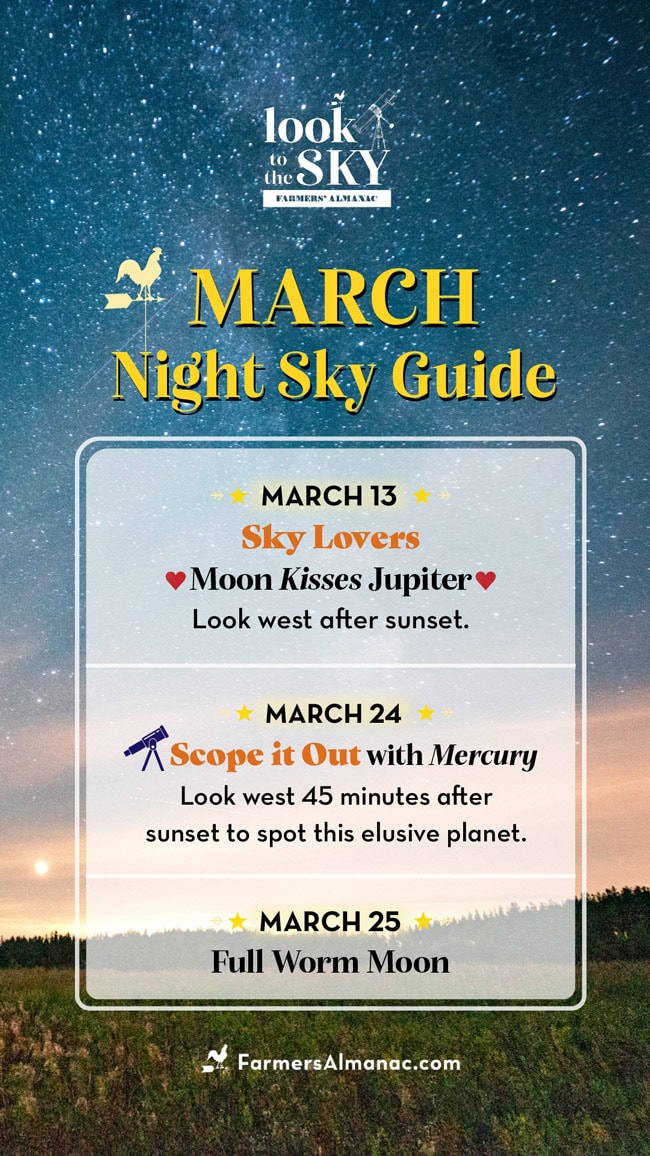
March Night Sky Guide
Farmers’ Almanac has provided Night Sky Guides and astronomical information since 1818. and All times and positions are listed in Eastern time, 40 degrees north of the equator—unless otherwise listed. If you see the terms sunset, midnight, sunrise or “local time,” this is true no matter where you are located (no need to add or subtract for your time zone).
March 3 – Antares Eclipsed By The Moon
Are you a night owl or a super early riser? Up for a challenge? Look low on the southeast horizon to witness a special sky event: an occultation (eclipse) of Antares, one of the brightest stars. The nearly last quarter Moon will move in front of Antares, making the star disappear behind the Moon’s bright side and then reappear about an hour later from behind the Moon’s shadowed side.
This event is quite rare because Antares is a pair of stars, and its dimmer companion will show up five seconds before Antares itself does. This gives us a rare chance to see it. However, this event will mostly be visible in the southeastern part of the US. In other places, people will notice Antares moving very close to the edge of the Moon.
Antares, which represents the “heart” of the Scorpius constellation. Cue music: Total Eclipse of the Heart. Antares is a very large star that is 550 light-years away and can be seen without telescopes. Its name comes from the Greek word that means “Rival to Ares,” with Ares being another name for the planet Mars. Indeed, Antares shines with a deep red color in the sky, which is quite different from the yellow-orange color of Mars.
Related: The 10 Brightest Stars
People in the northeastern and mid-Atlantic regions of the US will see the Moon and the star at their closest point around 2:40 a.m. Eastern Time, low in the southeast part of the sky. Some places will see Antares pass just a tiny bit above the top edge of the Moon.
For those living south of a line from Milwaukee, WI to Nags Head, NC, there’s an extra special view: the Moon will cover Antares. The further south you are, the longer Antares will be hidden. In Raleigh, NC, the star will disappear behind the Moon’s bright side at 2:21 a.m. Eastern Time and come back from behind the dark side at 2:48 a.m. In Atlanta, GA, the star will be hidden from 2:05 a.m. to 2:55 a.m., and in West Palm Beach, from 2:00 a.m. to 3:02 a.m.
For places further west, the Moon will have already moved past Antares by the time it rises above the horizon, but they will still seem very close to each other. From Denver, Antares will be spotted about 1 degree to the upper right of the Moon at 2:30 a.m. Mountain Time, and from Los Angeles, the space between them will be about 1.2 degrees at 1:50 a.m. Pacific Time.
Speaking of eclipses: Are you prepared for the Total Solar Eclipse coming on April 8, 2024? See locations and weather predictions now!
The last quarter Moon occurs at 10:23 a.m. EST. Learn more about the phases of the Moon
🔭 March 7 – Venus And The Crescent Moon
About 45 minutes before the Sun comes up, look low towards the southeast part of the sky to see a thin waning crescent Moon. Positioned about 18 degrees to its left, Venus shines brightly. Meanwhile, closer to the Moon than to Venus, a much dimmer Mars adds to the morning sky’s beauty.
Venus announces the coming of morning in March, appearing in the east-southeast almost an hour before sunrise, though this time decreases to about 25 minutes by the end of the month as April gets closer. Right now, Venus is at its least bright for the year, with a shine of -3.9. This brightness stays the same as Venus slowly moves closer to the Sun’s light, and eventually, it will disappear from our sight in April.
On the other hand, Mars, with a brightness of +1.2, can be seen just above the east-southeastern part of the sky as the daylight starts to brighten the sky. To see it clearly against the morning light, using binoculars will help you see it better.
March 10 – New Moon And Daylight Saving Time Begins
The New Moon occurs at 5:00 a.m. Eastern Daylight Time today. Just two hours before, the Moon reaches the nearest point in its path around the Earth, at a distance of 221,764 miles. This close timing of the New Moon and its closest point to Earth will cause a large difference between the high and low sea tides. If there are coastal storms at this time, they might make flooding on the coasts worse. This situation with the extreme tides is called a perigean spring tide, where “spring” comes from a German word meaning “to jump up,” and it’s not about the season of spring.
Related: Why the New Moon is ideal for stargazing
It’s important to mention the debate about the term “supermoon,” which is sometimes used for both full and new Moons that happen when the Moon is at this close point. Some people call new Moons “supermoons,” but usually, we think of full Moons as “supermoons” because they look very bright and big when close to Earth. This difference in how the term is used can make it unclear for those who watch the skies.
Psst … the New Moon in April will be a Total Solar Eclipse! Don’t miss it! See total eclipse locations and regional weather for each!
Also, Daylight Saving Time starts on the second Sunday in March. In most places in the United States, except Arizona and Hawaii, as well as the Canadian province of Saskatchewan, you should set your clocks one hour ahead at 2:00 a.m. A simple way to remember this is: “Spring forward, Fall back.”
March 11-15 – Wish Upon A Star In The March Night Sky
This week, find the Big Dipper in the east-northeast part of the sky (its ladle appears to be pointing upward). Then locate a group of dim stars to the lower right: Canes Venatici, which means “the hunting dogs.” In old stories, these dogs were seen as chasing the Big Bear (Ursa Major, which includes the Big Dipper) in the sky.
The brightest star in this group is not very bright, at only third magnitude, but it’s important because of a name given to it by Edmund Halley in 1725: Cor Caroli, which stands for “Charles’s heart.” This name came from Sir Charles Scarborough, a royal doctor, who noticed it shining very brightly on the night of May 29, 1660, when Charles II became king of England again.
Given recent news about King Charles III, you may consider wishing upon this special star.
Related: Shooting Stars And Good Luck
⭐ March 13 – Jupiter Kisses The Moon
The celestial romance between Jupiter and the Moon continues as they draw close once more, reminiscent of their enchanting Valentine’s Day rendezvous (in February Night Sky Guide.) Jupiter and the Moon are set to reunite in March.
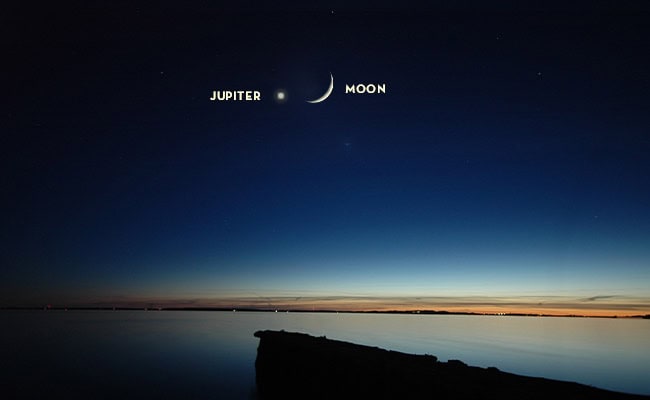
The radiant “evening star,” Jupiter is a captivating sight in the western sky at dusk, seemingly drawing the Moon closer with its bright light. Don’t miss this celestial love story unfolding … and stay tuned for what April may have in store for this couple!
March 17 – First Quarter Moon
The first quarter Moon occurs on St. Patrick’s Day at 12:11 a.m. EDT.
March 19 – First Day Of Spring
At 11:06 p.m. EDT, an astronomical event marks the transition of seasons: Sun moves across an imaginary line in the sky, heading north. This event means that spring is starting in the Northern Hemisphere and autumn is beginning in the Southern Hemisphere.
Related: Spring Extended Weather Predictions
This year, the first day of spring is happening earlier than it has in 128 years, mostly because of the special leap year in 2000. Leap years follow a rule where only century years that can be divided by 400 are leap years. This is why years like 1700, 1800, and 1900 were not leap years, but 2000 was different. If 2000 hadn’t been a leap year, the first day of spring would have been one day later, on March 20th.
🔭 March 21 – Saturn And Venus
This morning offers a beautiful sky event: Saturn, with a brightness of +1.0, might be seen about 30 minutes before the Sun comes up. Look towards the east-southeast part of the sky, where Saturn starts to shine just a little bit to the lower left of the much brighter Venus. Using binoculars might help you see these two planets, which will be very low in the sky.
Related: Visible Planets Guide
What’s special about this moment is the side-by-side appearance of Saturn and Venus, two of the most noticeable planets in our solar system. Venus is very bright, and the addition of Saturn gives an interesting touch to the sky before sunrise. But this closeness won’t last long; in the next few days, Saturn will slowly move away from Venus, going upwards to the right. At the same time, Venus will move down towards the bright light of the Sun coming up. Keep watching this changing relationship between two of the sky’s big planets as they move in the morning sky.
⭐ March 24 – Scope It Out With Mercury (And Jupiter)
This evening, there’s a notable sky event: Mercury is as far east from the Sun as it will get, sitting 19 degrees away from it. Around this time, Mercury can be seen in the sky after the evening light fades, which is a special chance for people watching from the middle-north regions—the only time this year you can see it.
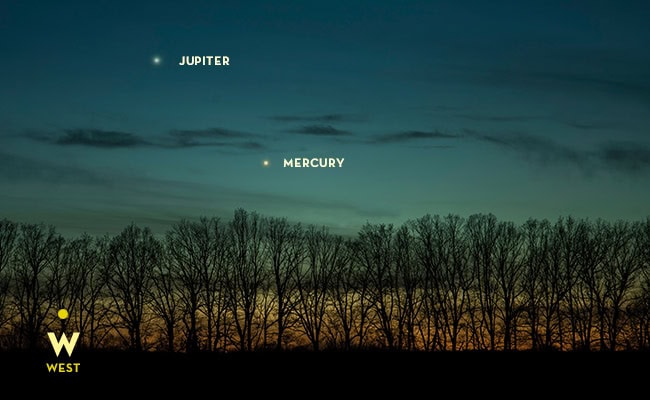
Mercury is often tricky to spot, leading to a well-known, but probably not true, story that even Copernicus never saw it. But if you look at the right time and on the right dates, you can definitely see Mercury—it’s a chance you shouldn’t miss. Just look low towards the west about 40 to 60 minutes after the Sun sets, and you’ll find Mercury about 22 degrees to the lower right of Jupiter, the only bright “star” nearby. If you use a telescope, you’ll see Mercury as a small, half-lit circle.
⭐ March 25 – Full Worm Moon
The Full Worm Moon reaches peak illumination in the March sky at 3 a.m. EDT. Around this time, the Moon will undergo a partial lunar eclipse. While the Moon almost completely avoids the Earth’s shadow, it just touches the lightest part of the shadow, called the penumbra. This light shadow, which gets fainter towards the edges, will gently brush across the Moon during the eclipse, creating a barely noticeable show.
This lunar eclipse is best seen from the Western Hemisphere, while the “Old World” (the Eastern Hemisphere) won’t be able to see it because it happens during their day when the Moon is not in the sky. The darkest part of the shadow, called the umbra, is actually missing the Moon and is to the south of where the Moon is traveling.
In the middle of the eclipse, around 3:12 a.m. Eastern Daylight Time, if you look closely, you might see a slight grayish mark near the bottom edge of the Moon for about 30 minutes.
Two weeks after this, the Moon will move to the other side of its orbit, and when it’s in the new phase, it will throw its dark shadow on North America, signaling that a big solar eclipse is coming.
Related: Learn why the March full Moon is called the Worm Moon
Related
Monthly Stargazing Night Sky Guide
Join The Discussion
What are you excited about in the March night sky?
Do you have any suggestions for our sky guide?
Share with your community here in the comments below!

Joe Rao
Joe Rao is an esteemed astronomer who writes for Space.com, Sky & Telescope, and Natural History Magazine. Mr. Rao is a regular contributor to the Farmers' Almanacand serves as an associate lecturer for the Hayden Planetarium in New York City.

